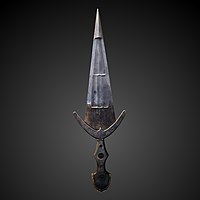Cinquedea
| Cinquedea | |
|---|---|
 Cinquedea on display at the Arts and History Museum of Geneva | |
| Type | long dagger |
| Place of origin | Italy |
The cinquedea or cinqueda is a civilian short sword (or long dagger). It was developed in northern Italy and enjoyed a period of popularity during the Italian renaissance of the 15th and early 16th centuries.[1][2]
The name cinquedea means "five fingers", and it describes the width of the blade next to the guard.[citation needed] The blade was heavy, about 45 cm (18 in) in length, and tapered to a somewhat rounded point. The grip was simple with a small pommel, and the guard was curved with the concave side toward the point. There were typically several fullers along the wider sides of the blade to lighten the weapon. The wide blade was useful for decorative etching. The wide blade was also used for attacking rather than the point of the blade. This weapon was varied in size, being anywhere from 10–28 in (250–710 mm) in length. It was often carried in place of a knife or larger sword. It is depicted in period art as sometimes being carried horizontally next to the buttocks so that it could be drawn laterally from the back. The cinqueda was able to deal cutting blows unlike most other daggers because of its size and shape.
See also
- List of daggers
- Anelace
References
- ^ "Cinquedea ca. 1500". Metropolitan Museum of Art. Retrieved 29 March 2020.
- ^ George, Gene. "The Cinquedea by Lutel: Threat or Menace". myArmoury.com. Retrieved 29 March 2020.
External links

- The Cinquedea by Lutel: Threat or Menace
- v
- t
- e
- List of daggers
- List of blade materials
table knives
- Aircrew Survival Egress Knife
- Athame
- Balisong/Butterfly
- Ballistic
- Ballpoint pen knife
- Bayonet
- Boline
- Bolo
- Boot knife
- Bowie
- Cane knife
- Ceramic knife
- Clip point
- Combat knife
- Commander
- Corvo
- CQC-6
- Deba bōchō
- Diving knife
- Drop point
- Fairbairn–Sykes fighting knife
- Gerber Mark II
- Ginsu
- Golok
- Gravity knife
- Guna
- Hacking knife
- Higonokami
- Hunting knife
- Husa knife
- Ivan's Knife
- Jacob's ladder
- Karambit
- Kard
- Kirpan
- Kitchen knife
- Kukri
- Laguiole knife
- Machete
- Mandau
- Marking knife
- Misericorde
- Mora knife
- Multi-tool
- Navaja
- Neck knife
- Nontron knife
- Opinel knife
- Palette knife
- Pantographic knife
- Parang
- Penknife
- Penny knife
- Pesh-kabz
- Pirah
- Pocketknife
- Phurba
- Putty knife
- Puukko
- Rampuri
- Resolza
- Sabatier
- Sami knife
- SARK
- Scalpel
- Seax
- Sgian dubh
- Sharpfinger
- Sheath knife
- Shiv
- Sliding knife
- Smatchet
- SOG Knife
- Straight razor
- Strider SMF
- Survival knife
- Swiss Army knife
- Switchblade
- Taping knife
- Throwing knife
- Trench knife
- Tumi
- Ulu
- Utility knife
- Warrior knife
- Wedung
- X-Acto
- Yarara Parachute Knife
- Yatagan
- Anelace
- Applegate–Fairbairn fighting knife
- Arkansas toothpick
- BC-41
- Bagh nakh
- Balarao
- Baselard
- Bichuwa
- Bollock dagger
- Cinquedea
- Dha
- Dirk
- Ear dagger
- Emeici
- Facón
- French Nail
- Gunong
- Hunting dagger
- Janbiya
- Jile
- Kabutowari
- Kaiken
- Kalis
- Katar
- Khanjali
- Khanjar
- Kris
- Kunai
- Liaoning dagger
- Mark I trench knife
- Microtech Jagdkommando
- Parrying dagger
- Poignard
- Pugio
- Push dagger
- Rondel dagger
- Seme
- Shobo
- Sica
- Stiletto
- Tantō
- U.S. Marine Raider stiletto
- V-42
- Yoroi-dōshi
- Aitor Knife Company
- Al Mar Knives
- American Tomahawk Company
- Aritsugu
- Benchmade
- Böker
- Buck Knives
- Camillus Cutlery Company
- Cattaraugus Cutlery Company
- Chris Reeve Knives
- Chroma Cnife
- Clauss Cutlery Company
- Cobray Company
- Cold Steel
- Columbia River Knife & Tool
- Cuisinart
- Cutco
- Dalian Hanwei Metal
- Dexter-Russell
- Ek Commando Knife Co.
- EKA
- Emerson Knives
- F. Dick
- Fällkniven
- FAMAE
- Fiskars
- Füritechnics
- Glock Ges.m.b.H.
- Imperial Schrade
- Ivan's
- Ka-Bar
- Kershaw Knives
- KitchenAid
- Korin Japanese Trading Company
- Kyocera
- Leatherman
- Mad Dog Knives
- Marble Arms
- Medford Knife and Tool
- Microtech Knives
- Morseth
- Muela
- Murphy Knives
- Olfa
- Ontario Knife Company
- Opinel
- Randall Made Knives
- Ranz Cuchillos
- Rösle
- Sabatier
- Shun Cutlery
- Slice, Inc.
- SOG Specialty Knives
- Spyderco
- STI Knives
- Strider Knives
- Thiers Issard
- TOPS Knives
- Tramontina
- Victorinox
- W. R. Case & Sons Cutlery Co.
- Carl Walther GmbH
- Wenger
- Western Knife Company
- Wilkinson Sword
- Wüsthof
- Yoshida Metal Industry
- Global
- Zero Tolerance Knives
- Zwilling J. A. Henckels
- Rex Applegate
- James Black
- Blackie Collins
- John Nelson Cooper
- Ernest Emerson
- Jerry Fisk
- Bill Harsey Jr.
- Phill Hartsfield
- Gil Hibben
- Jimmy Lile
- Bob Loveless
- William F. Moran
- Ken Onion
- Ralph Osterhout
- Bo Randall
- Chris Reeve
- A. G. Russell
- Jody Samson
- William Scagel
- Mike Snody
- Robert Terzuola
- Michael Walker
- Buster Warenski
- Daniel Winkler
 Category:Knives / Daggers
Category:Knives / Daggers













